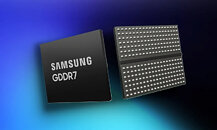- Joined
- Oct 9, 2007
- Messages
- 47,164 (7.57/day)
- Location
- Hyderabad, India
| System Name | RBMK-1000 |
|---|---|
| Processor | AMD Ryzen 7 5700G |
| Motherboard | ASUS ROG Strix B450-E Gaming |
| Cooling | DeepCool Gammax L240 V2 |
| Memory | 2x 8GB G.Skill Sniper X |
| Video Card(s) | Palit GeForce RTX 2080 SUPER GameRock |
| Storage | Western Digital Black NVMe 512GB |
| Display(s) | BenQ 1440p 60 Hz 27-inch |
| Case | Corsair Carbide 100R |
| Audio Device(s) | ASUS SupremeFX S1220A |
| Power Supply | Cooler Master MWE Gold 650W |
| Mouse | ASUS ROG Strix Impact |
| Keyboard | Gamdias Hermes E2 |
| Software | Windows 11 Pro |
The first round of NVIDIA GeForce RTX 50-series "Blackwell" graphics cards that implement GDDR7 memory are rumored to come with a memory speed of 28 Gbps, according to kopite7kimi, a reliable source with NVIDIA leaks. This is despite the fact that the first GDDR7 memory chips will be capable of 32 Gbps speeds. NVIDIA will also stick with 16 Gbit densities for the GDDR7 memory chips, which means memory sizes could remain largely unchanged for the next generation; with the 28 Gbps GDDR7 memory chips providing 55% higher bandwidth over 18 Gbps GDDR6 and 33% higher bandwidth than 21 Gbps GDDR6X. It remains to be seen what memory bus widths NVIDIA chooses for its individual SKUs.
NVIDIA's decision to use 28 Gbps as its memory speeds has some precedent in recent history. The company's first GPUs to implement GDDR6, the RTX 20-series "Turing," opted for 14 Gbps speeds despite 16 Gbps GDDR6 chips being available. 28 Gbps is exactly double that speed. Future generations of GeForce RTX GPUs, or even refreshes within the RTX 50-series could see NVIDIA opt for higher memory speeds such as 32 Gbps. When the standard debuts, companies like Samsung even plan to put up fast 36 Gbps chips. Besides a generational doubling in speeds, GDDR7 is more energy-efficient as it operates at lower voltages than GDDR6. It also uses a more advanced PAM3 physical layer signaling compared to NRZ for JEDEC-standard GDDR6.

View at TechPowerUp Main Site | Source
NVIDIA's decision to use 28 Gbps as its memory speeds has some precedent in recent history. The company's first GPUs to implement GDDR6, the RTX 20-series "Turing," opted for 14 Gbps speeds despite 16 Gbps GDDR6 chips being available. 28 Gbps is exactly double that speed. Future generations of GeForce RTX GPUs, or even refreshes within the RTX 50-series could see NVIDIA opt for higher memory speeds such as 32 Gbps. When the standard debuts, companies like Samsung even plan to put up fast 36 Gbps chips. Besides a generational doubling in speeds, GDDR7 is more energy-efficient as it operates at lower voltages than GDDR6. It also uses a more advanced PAM3 physical layer signaling compared to NRZ for JEDEC-standard GDDR6.

View at TechPowerUp Main Site | Source




 On the plus side, my 4090 will remain relevant for longer I guess.
On the plus side, my 4090 will remain relevant for longer I guess.

